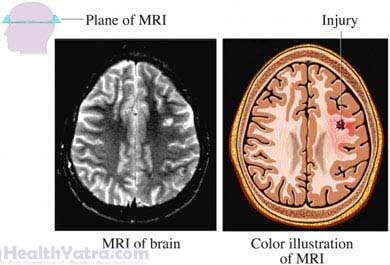تعريف
An MRI uses magnetic waves to make pictures of the inside of the body. It can make two-dimensional and three-dimensional pictures.
أسباب الاختبار
You may have an MRI to diagnose a condition or look for internal injuries. MRIs can look at any body part, from your head to your toes. MRIs can also be used to see if medication or treatment is working.

المضاعفات المحتملة
MRIs can be harmful if you have metal inside your body, such as joint replacements or a pacemaker. Make sure your doctor knows of any internal metal before the test.
A contrast dye may be used to enhance some images. Some people may have a bad reaction to this dye. Talk to your doctor about any allergies you have or if you have liver or kidney problems. Liver and kidney problems may make it difficult for your body to get rid of the contrast.
ما يمكن توقعه
قبل الاختبار
Follow your doctors instructions regarding eating and drinking before the test. This will depend on what part of the body is being examined.
At the MRI center:
Your doctor may give you a medicine to calm you if you are anxious about the test. If your doctor prescribes a sedative you will need to arrange for a ride home. Be sure to follow your doctor’s instructions on when to take the sedative. It may need to be taken 1-2 hours before the exam.
- You will be asked about the following:
- Medical and surgical history
- حمل
- الحساسية
- Other conditions that you may have—If your MRI involves contrast material, your doctor will ask about the health of your kidneys. There is a risk of complications in people who have kidney disease and receive contrast material.
- You will be asked if you have something in your body that would interfere with the MRI, such as:
- Pacemaker or implantable defibrillator.
- Neurostimulator.
- Ear implant.
- Metal fragments in your eyes or in any other part of your body. Be sure to tell your doctor if your work involves metal filings or particles.
- Implanted port device, such as an insulin pump.
- Metal plate, pins, screws, or surgical staples.
- Metal clips from aneurysm repair.
- Retained bullets.
- Any other large metal objects in your body. Tooth filling and braces are usually fine.
- You will be asked to remove any metal objects such as, jewelry, hearing aids, or glasses.
- You will also be asked to remove all medicine skin patches, such as Duragesic patch. They may contain metal elements and cause skin burns.
- An x-ray may be taken to check for any metal objects in your body.
You may be:
- Given ear plugs or headphones. The MRI machine makes a loud banging noise.
- Given an injection of contrast dye into your vein.
- Allowed to have a family member or friend with you during the test.
وصف الاختبار
If a contrast dye is used, a small IV needle is inserted into your hand or arm.
You will lie very still on a sliding table. Depending on your condition, you may have monitors to track your pulse, heart rate, and breathing. The table will slide into a narrow, enclosed cylinder. In some machines, the sides are open, so you can look out into the room.
The technician will leave the room. Through the intercom, the technician will give you directions. You can talk to the technician through this intercom as well. The technician will take the pictures. When the exam is done, you will slide out of the machine. If you have an IV needle, it will be removed.
If you are claustrophobic or unable to lie on a flat table, there are open MRI machines available. They allow you to have the test done without being put in a narrow cylinder. There are also MRI machines that allow a patient to be in a sitting position. This may be important for patients with concerns, like a painful back.
بعد الاختبار
You will be asked to wait at the facility while the images are examined. The technician may need more images.
If you took a sedative, do not drive, operate machinery, or make important decisions until it wears off completely.
If you are breastfeeding and receive a contrast dye, you and your doctor should discuss when you should resume breastfeeding. Information available has not found any ill effects to the baby of a breastfeeding mother who has had contrast dye.
كم من الوقت سيستغرق ؟
40-90 minutes
هل سيكون هناك ألم؟
The exam is painless. If you have dye injected, there may be stinging when the IV needle is inserted. You may also feel a slight cooling sensation as the dye is injected.
نتائج
After the exam, a radiologist will analyze the images and send a report to your doctor. Your doctor will talk to you about the results and any further tests or treatment.
استدعاء الطبيب
بعد الاختبار ، اتصل بطبيبك إذا حدث أي مما يلي:
- Worsening of symptoms
- Any allergic or abnormal symptoms, like getting a rash or swelling if you were injected with contrast dye
